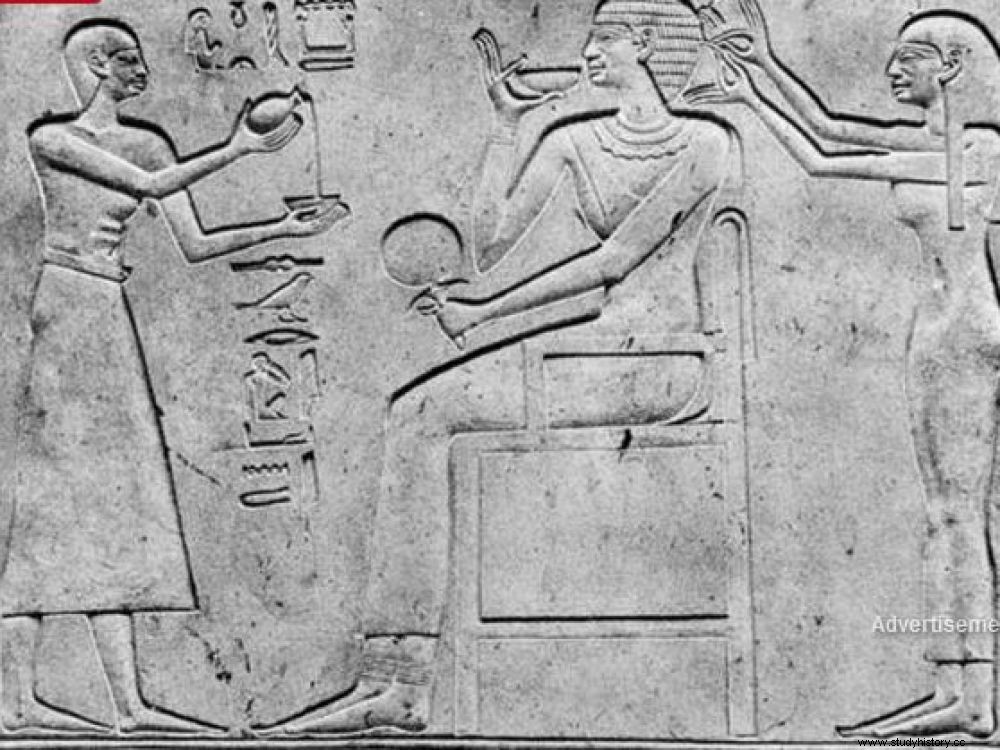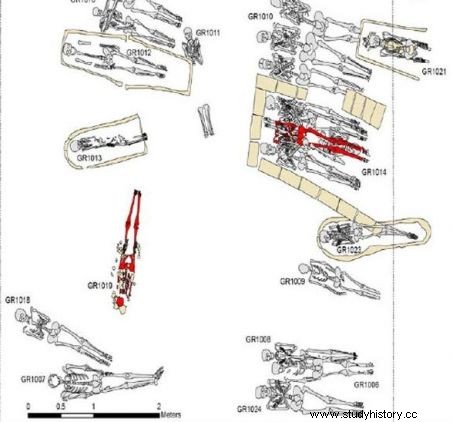Two rare cases of post-Pharaonic eunuchism may have been detected in northern Egypt.

Bas-relief from the sarcophagus of Princess Kaouit (11th dynasty), where a eunuch pours a drink for his mistress while a servant arranges her hair.
Plothin, the minister of Ptolemy XIII, the pharaoh of Egypt who had tried to have his sister Cleopatra assassinated, would have belonged to this very particular caste. But no archaeological remains of eunuchs, these men who have been victims since ancient times of the sexual mutilation that was castration (see box ), had not previously been found. It seems that this has now been done with the analyzes carried out on two skeletons exhumed between 2007 and 2013 in the governorate of Monufia, in Quesna, an Egyptian site from the Greco-Roman period (4th century BC-1 st). . century AD) According to Scott Haddow*, of the Pacea laboratory, UMR 5199 of the University of Bordeaux, Joanne Rowland of the Faculty of History, Classics and Archeology of the University of Edinburgh, and Sonia Zakrzwski, of the Department archeology from the University of Southampton, the bones would present probable traces of this mutilation.
During the annual meeting of the American Association of Physical Anthropologists - which was held from April 19 to 22, 2017 in New Orleans (USA) - the team detailed these physiological anomalies detected on the remains of two adolescents unearthed among 151 other remains. “We found that they were above average in stature and showed signs of abnormal bone growth. However, people castrated before puberty grow more than others, have narrow shoulders and thorax but wide hips , explains archaeologist Scott Haddow to Sciences et Avenir. However, this may also be linked to other causes, in particular genetic disorders that would have affected the endocrine system by causing the expression of sexually ambiguous physical traits. »

Location of two potential cases of eunuchism (in red), in the Greco-Roman cemetery of Quesna, in the Nile Delta, Egypt. ©Scott Haddow, Sonia Zakrzwski, Joanne Rowland.
Be that as it may, the unusual funerary orientation of the first skeleton from the Ptolemaic period (B21), head to the south, unlike the hundred or so other skeletons found on the exhumed sites, head to the north, clearly evokes a specific burial.

Remains of B21, in the necropolis of Quesna, Egypt. © Scott Haddow, Sonia Zakrzwski, Joanne Rowland.
As well as the large number of funerary amulets associated with him, clearly indicating a separate treatment. This was not the case of the second skeleton (B26), from a later Roman period, which could suggest a better integration of eunuchs into the society of the time. “He was found in a mass mud-brick grave, among other deceased, which suggests that in the Roman period, intersex individuals were more accepted », continues the researcher.

Common tomb from Roman times in which B26 was found. © Scott Haddow, Sonia Zakrzwski, Joanne Rowland.
In the case of this teenager, it could be pre-pubertal castration, but the teenager could also have Klinefelter syndrome (the presence of an extra X chromosome). "We can only be sure after DNA analysis “, wanted to specify Scott Harrow. Domitian (81-96) would have been the first Roman emperor to ban this practice.
Eunuchs, castrated men
This mutilation was either suffered, during a punishment for example, or voluntary because it was essential to perform certain jobs, especially in the royal harems and gyneceums. Castration was carried out according to three types of process:amputation of the penis alone, removal of the testicular apparatus or total emasculation. This mutilation has taken place in many civilizations since the highest antiquity. The oldest reported cases go back to Akkadian texts from Lagash, in the 21st century BC, others in Assyria, where these characters also had important political roles in the Babylonian or Persian royal courts.
The Bible is no exception. In a passage from Genesis, Potiphar is mentioned as the pharaoh's eunuch. At the end of the Ming dynasty (1644), China had nearly 70,000 eunuchs in the Forbidden City and there were still 470 left when the Qing dynasty fell in 1912. thus ensured that these high officials could never have sexual relations with the royal wives or be tempted to take power to found a dynasty. This did not prevent Ammenemes, Egyptian ruler of the twelfth dynasty, from being assassinated by his own eunuchs. In the Byzantine Empire, they played a major political role, particularly in Constantinople where the eunuchs (hadim ) were responsible for the administration of the harems. This practice continued in the West with the "castrates":women were not allowed to sing in churches, young boys were subjected to these mutilations until the 18th century. Perhaps the most famous of these was the Italian Carlo Maria Michele Angelo Broschi, who died in 1705 and was known as "Farinelli".
*Two Potential Cases of Eunuchism from a Ptolemaic-Roman Cemetery in the Western Delta of Egypt:Differential Diagnosis and Social Implications. Scott D. Haddow, Sonia Zakrzewski, Joanne Rowland
